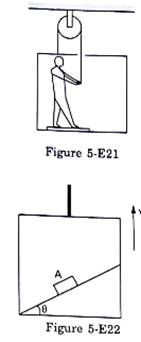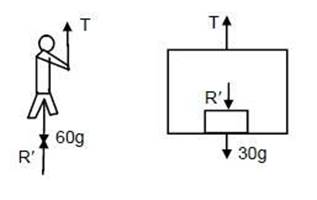Figure (5-E21) shows a man of mass 60 kg standing on a light weighing machine kept in a box of mass 30 kg. The box is hanging from a pulley fixed to the ceiling through a light rope, the other end of which is held by the man himself. If the man manages to keep the box at rest, what is the weight shown by the machine? What force should he exert on the rope to get his correct weight on the machine?


Given: i) Given, mass of the man = 60 kg
Let W‘= apparent weight of the man in this case
From the free-body diagram of the man, W‘+ T − 60g = 0
⇒ T = 60g − W‘ …(i)
From the free-body diagram of the box,
T − W‘= 30g = 0 …(ii)
From equation (i), we get: 60g − W‘− W‘− 30g = 0
⇒ W‘= 15g
Hence, the weight recorded on the machine is 15 kg.
(ii) To find his actual weight, suppose the force applied by the men on the rope is T because of which the box accelerates upward with an acceleration a‘ .Here we need to find
Correct weight = W = 60g
From the free-body diagram of the man, T’ + W − 60g − 60a = 0
⇒ T’ − 60a = 0
⇒ T’ = 60a …(i)
From the free-body diagram of the box, T’ − W − 30g − 30a = 0
⇒ T’ − 60g − 30g − 30a = 0
⇒ T’ = 30a − 900 …(ii)
From equations (i) and (ii), we get: T’ = 2T’ – 1800 = T’ = 1800 N
So, the man should exert a force of 1800 N on the rope to record his correct weight on the machine